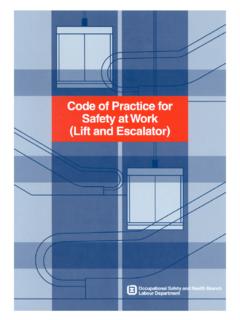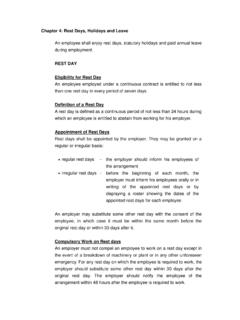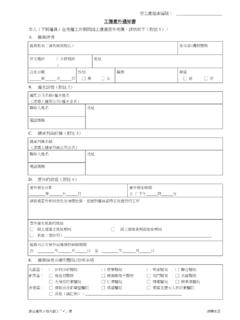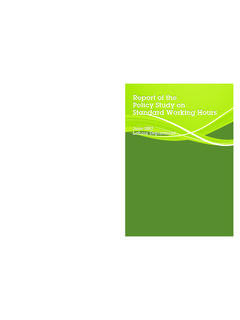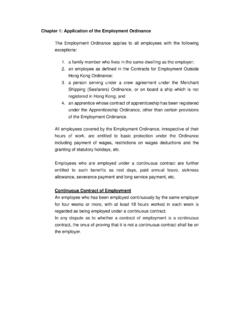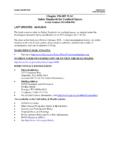Transcription of Safe Work in Confined Spaces - labour.gov.hk
1 Safe Work in Confined Spaces This publication is prepared by the Occupational Safety and Health Branch Labour Department Edition November 2010 This publication is issued free of charge and can be obtained from the offices of the Occupational Safety and Health Branch of the Labour Department. For enquiries about addresses and telephone numbers of the offices, please refer to the Labour Department s website at This publication may be freely reproduced except for advertising, endorsement or commercial purposes.
2 Please acknowledge the source as "Safe Work in Confined Spaces ", published by the Labour Department. 1 CONTENTS Page 1 Introduction 2 Confined Spaces can be deadly 1 3 What is a Confined space ? 4 What are the dangers from Confined Spaces ? 5 Basic principles of safety precautions for Confined space work Avoid entering Confined Spaces 6 Safe system of work 7 Emergency plan 14 6 Relevant legislation 16 7 Relevant publications of the Department 16 8 Enquiries 16 9 Complaints 16 1 3 1 Introduction This booklet is mainly aimed at proprietors or contractors whose employees are required to carry out work in Confined Spaces .
3 It contains simple and practical guidance on safe work in Confined Spaces and other useful information. It will also be a useful source of information on protecting personal safety and health at work for self-employed persons, employees and anyone involved in carrying out work in Confined Spaces . For the Factories and Industrial Undertakings ( Confined Spaces ) Regulation enacted in 1999, please refer to the relevant brief guide published by the Labour Department. 2 Confined Spaces can be deadly Work in Confined Spaces can kill or cause injuries in any industries, ranging from those involving complex plant through to simple storage.
4 Those victims include not only people working in the Confined space but also those who try to rescue them without proper training and equipment. 3 What is a Confined space ? It can be any space in which, by virtue of its enclosed nature, there arises a risk of death or serious injury for people working there. 1 Some Confined Spaces are fairly easy to identify, enclosures with limited openings: storage tanks; silos; reaction vessels; enclosed drains; sewers; wells; tunnels; pits; caissons; shafts. Others may be less obvious, but can be equally dangerous, for example: chambers; vats; combustion chambers in furnaces; pipes; unventilated or poorly ventilated rooms; flues; hatches.
5 It is not possible to provide a comprehensive list of Confined Spaces . Some places may become Confined Spaces when work is carried out, or during their construction, fabrication or subsequent modification. 2 4 What are the dangers from Confined Spaces ? Dangers can arise in Confined Spaces because of: Fire or explosion, from flammable vapours, excess oxygen, etc. Presence of dust in high concentrations, in flour silos. Hot conditions leading to a dangerous increase in body temperature. A lack of oxygen. This can occur: -where there is a reaction between the soils and the oxygen in the atmosphere, resulting in the oxygen being used up by the soil ingredients; -where there is a reaction between the goods stored and the oxygen in the atmosphere, resulting in the oxygen being used up; - inside steel tanks and vessels when rust forms.
6 3 Poisonous gases, fumes or vapours. These can: -build up in sewers and manholes and in pits connected to the system; - enter tanks or vessels from connecting pipes; - leak into trenches and pits in contaminated land, such as old refuse tips and old gas works. Liquids and solids which can suddenly release hazardous gases, fumes or vapours when disturbed. Residues left in tanks, vessels, etc. which can give off hazardous gases, fumes or vapours. Drowning of workers arising from an increase in the level of liquid. Free flowing solids such as grain and concrete which can partially solidify or bridge in silos.
7 They can collapse unexpectedly when disturbed and press against workers resulting in asphyxiation. 4 Some of the above conditions may already be present in the Confined space . However, some may arise through the work being carried out, or because of ineffective isolation of plant nearby, leakage from a pipe connected to the Confined space . The enclosed working space may also give rise to other dangers due to the work being carried out. For example: Machinery being used may generate dust and require special precautions, such as provision of local exhaust system for portable grinders or special precautions against electric shock; Hazardous gases, fumes or vapours can arise from welding, or by use of volatile and flammable solvents, adhesives, etc.
8 5 5 Basic principles of safety precautions for Confined space work Avoid entering Confined Spaces , by doing the work from outside; If entry to a Confined space is unavoidable, develop and implement a safe system of work; and Devise an appropriate emergency plan before the work starts. The following is an elaboration of these basic principles and what you need to do. Avoid entering Confined Spaces You need to check if the work can be done another way so that entry to or work in Confined Spaces is avoided.
9 Better work-planning or a different approach can reduce the need for Confined space working. Ask yourself if the intended work is really necessary, or if you could: modify the Confined space itself or other plant to eliminate the Confined space ; have the work done from outside, for example: -blockages in silos can be cleared by use of remotely operated vibrators or air washers; -inspection, sampling and cleaning operations can be done from outside the space using appropriate equipment and tools; and - remote control monitors can be used for internal inspection of vessels.
10 6 Safe system of work If entry to a Confined space is unavoidable, a safe system for working inside the space should be developed. A competent person should be appointed to carry out a risk assessment of the conditions and the work and activities to be conducted in the Confined space , and identify the necessary safety precautions to be taken according to the findings to avoid posing hazards to workers. The competent person should make recommendations on safety precautions to be taken having regard to the nature of the Confined space , the associated risk and the work involved.
